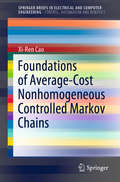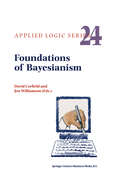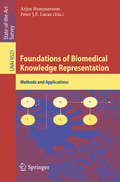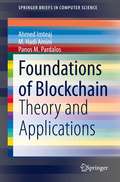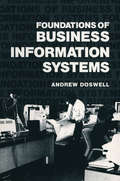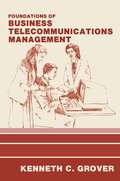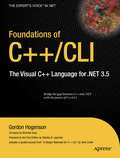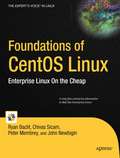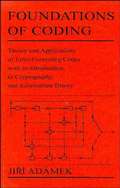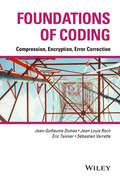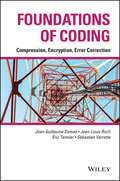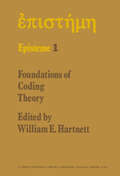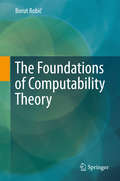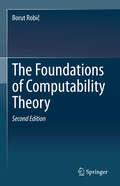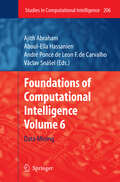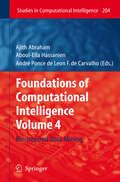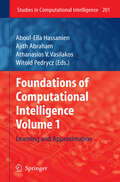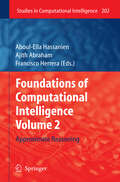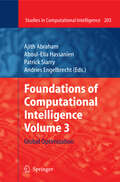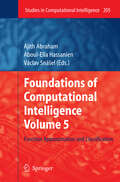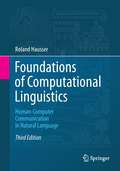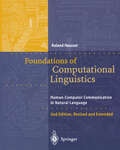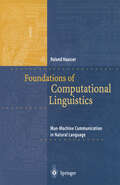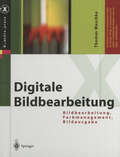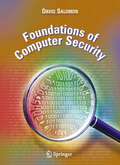- Table View
- List View
Foundations of Average-Cost Nonhomogeneous Controlled Markov Chains (SpringerBriefs in Electrical and Computer Engineering)
by Xi-Ren CaoThis Springer brief addresses the challenges encountered in the study of the optimization of time-nonhomogeneous Markov chains. It develops new insights and new methodologies for systems in which concepts such as stationarity, ergodicity, periodicity and connectivity do not apply. This brief introduces the novel concept of confluencity and applies a relative optimization approach. It develops a comprehensive theory for optimization of the long-run average of time-nonhomogeneous Markov chains. The book shows that confluencity is the most fundamental concept in optimization, and that relative optimization is more suitable for treating the systems under consideration than standard ideas of dynamic programming. Using confluencity and relative optimization, the author classifies states as confluent or branching and shows how the under-selectivity issue of the long-run average can be easily addressed, multi-class optimization implemented, and Nth biases and Blackwell optimality conditions derived. These results are presented in a book for the first time and so may enhance the understanding of optimization and motivate new research ideas in the area.
Foundations of Bayesianism (Applied Logic Series #24)
by D. Corfield J. WilliamsonThis is an authoritative collection of papers addressing the key challenges that face the Bayesian interpretation of probability today. The volume includes important criticisms of Bayesian reasoning and gives an insight into some of the points of disagreement amongst advocates of the Bayesian approach. It will be of interest to graduate students, researchers, those involved with the applications of Bayesian reasoning, and philosophers.
Foundations of Biomedical Knowledge Representation: Methods and Applications (Lecture Notes in Computer Science #9521)
by Arjen Hommersom Peter J.F. LucasMedicine and health care are currently faced with a significant rise in their complexity. This is partly due to the progress made during the past three decades in the fundamental biological understanding of the causes of health and disease at the molecular, (sub)cellular, and organ level. Since the end of the 1970s, when knowledge representation and reasoning in the biomedical field became a separate area of research, huge progress has been made in the development of methods and tools that are finally able to impact on the way medicine is being practiced. Even though there are huge differences in the techniques and methods used by biomedical researchers, there is now an increasing tendency to share research results in terms of formal knowledge representation methods, such as ontologies, statistical models, network models, and mathematical models. As there is an urgent need for health-care professionals to make better decisions, computer-based support using this knowledge is now becoming increasingly important. It may also be the only way to integrate research results from the different parts of the spectrum of biomedical and clinical research. The aim of this book is to shed light on developments in knowledge representation at different levels of biomedical application, ranging from human biology to clinical guidelines, and using different techniques, from probability theory and differential equations to logic. The book starts with two introductory chapters followed by 18 contributions organized in the following topical sections: diagnosis of disease; monitoring of health and disease and conformance; assessment of health and personalization; prediction and prognosis of health and disease; treatment of disease; and recommendations.
Foundations of Blockchain: Theory and Applications (SpringerBriefs in Computer Science)
by Ahmed Imteaj M. Hadi Amini Panos M. PardalosThis book provides a comprehensive analysis of fundamental topics related to blockchain. Throughout, the authors explore different vital issues and specific areas of blockchain. For convenience, the authors present the elementary description, visualize the working procedure of blockchain paradigm, and highlight the areas it can be applied in real life. They explain the blockchain process from a diverse perspective i.e. distributed Internet of Things (IoT), interdependent networks, intelligent mining, etc. They also analyze the interconnection of a blockchain network and such novel research areas to show a pathway towards a new research direction. This book also holds the core challenges and open research issues of blockchain technology, considering existing applications. Chapters include consensus mechanisms of blockchain, blockchain applicability in centralized and decentralized internet of things, blockchain interoperability from the perspective of interdependent networks, and blockchain for resource-constrained devices.Specifies the importance of theoretical methods in dealing with problems in the context of blockchain for interdependent decision making;Provides a comprehensive investigation of blockchain algorithms and the recently developed methods based on this algorithm;Provides basics and mathematical foundations needed to learn and deploy blockchain.
Foundations of Business Information Systems (Approaches to Information Technology)
by Andrew DoswellA few years ago there were no books on information technology and business, now there are a great many. To add to that flow calls for courage and judgment on the part of both a potential author and publisher. Andrew Doswell and Plenum Press are justified in bringing this work into the market. The main reason is that Andrew Doswell has brought to the work some simple yet formidable attributes. The first of these is that he knows what he is talking about. He was trained as an electrical engineer; he then was employed in business, drawing on and fortifying that training, where he moved into an administrative position. Later still he moved into teaching, first in Ireland, then in Scotland, but while employed in education he has not become an academic recluse. On the contrary, he has continued to maintain his links with business, doing so by engaging in both research and consultancy. Within the University he has been at the forefront of our thrust into office automation and office information systems.
Foundations of Business Telecommunications Management (Approaches to Information Technology)
by Kenneth C. Groverlnfonnation technology is about more than computers. Thus, it was a recurring-and rather infuriating-aspect of the early discussions on infonnation technology that those who participated tended either to ignore or to severely understate the role in infonnation technology of telecommunications. This very fine book by Ken Grover goes a long way toward correcting that misconception. However important the computer and computer-based equipment might be, the role of telecommunications equip ment has also been and continues to be significant. Moreover, as the author brings out, it is going to be even more important. As this enthralling story unfolds the reader will find him or herself continually remarking that there cannot be more-but again and again, there is. Those who are already of the world of telecommunications will, on reading this work, be proud of their colleague. Those who are already of the world of computers will learn a great deal and, it is to be hoped, will in future be fairer toward telecommunications than they have been in the past. Those who are new to the world of information technology will sally forth better balanced than most.
Foundations of C++/CLI: The Visual C++ Language for .NET 3.5 (The\expert's Voice In .net Ser.)
by Gordon HogensonFoundations of C++/CLI: The Visual C++ Language for .NET 3.5 introduces C++/CLI, Microsoft's extensions to the C++ syntax that allow you to target the common language runtime, the key to the heart of the .NET Framework 3.5. This book gives you a small, fast–paced primer that will kick–start your journey into the world of C++/CLI. In 13 no–fluff chapters, Microsoft insiders take readers into the core of the C++/CLI language and explain both how the language elements work and how Microsoft intends them to be used. This book is a beginner's guide, but it assumes a familiarity with programming basics. And it concentrates on explaining the aspects of C++/CLI that make it the most powerful and fun language of the .NET Framework. As such, this book is ideal if you're thinking of migrating to C++/CLI from another language. By the end of this book, you'll have a thorough grounding in the core language elements together with the confidence to explore further that comes from a solid understanding of a language's syntax and grammar.
Foundations of CentOS Linux: Enterprise Linux On the Cheap
by Chivas Sicam Ryan Baclit Peter Membrey John NewbiginYou need to maintain clients, servers and networks, while acquiring new skills. Foundations of Cent OS Linux: Enterprise Linux On the Cheap covers a free, unencumbered Linux operating system within the Red Hat lineage, but it does not assume you have a Red Hat Enterprise Linux license. Now you can learn CentOS Linux, the most powerful and popular of all Red Hat clones, keep maintaining your network at work, and become an Red Hat Certified Engineer, all just for the cost of this book. Introduces CentOS Linux and Fedora clients as equals to Red Hat Enterprise Linux Sets up CentOS as a secure, high–performance web services back end Prepares you for the RHCE examination, but does not assume an RHEL installation
Foundations of Coding: Theory and Applications of Error-Correcting Codes with an Introduction to Cryptography and Information Theory
by Jiri AdamekAlthough devoted to constructions of good codes for error control, secrecy or data compression, the emphasis is on the first direction. Introduces a number of important classes of error-detecting and error-correcting codes as well as their decoding methods. Background material on modern algebra is presented where required. The role of error-correcting codes in modern cryptography is treated as are data compression and other topics related to information theory. The definition-theorem proof style used in mathematics texts is employed through the book but formalism is avoided wherever possible.
Foundations of Coding: Compression, Encryption, Error Correction
by Jean-Guillaume Dumas Jean-Louis Roch Éric Tannier Sébastien VarretteOffers a comprehensive introduction to the fundamental structures and applications of a wide range of contemporary coding operations This book offers a comprehensive introduction to the fundamental structures and applications of a wide range of contemporary coding operations. This text focuses on the ways to structure information so that its transmission will be in the safest, quickest, and most efficient and error-free manner possible. All coding operations are covered in a single framework, with initial chapters addressing early mathematical models and algorithmic developments which led to the structure of code. After discussing the general foundations of code, chapters proceed to cover individual topics such as notions of compression, cryptography, detection, and correction codes. Both classical coding theories and the most cutting-edge models are addressed, along with helpful exercises of varying complexities to enhance comprehension. Explains how to structure coding information so that its transmission is safe, error-free, efficient, and fast Includes a pseudo-code that readers may implement in their preferential programming language Features descriptive diagrams and illustrations, and almost 150 exercises, with corrections, of varying complexity to enhance comprehension Foundations of Coding: Compression, Encryption, Error-Correction is an invaluable resource for understanding the various ways information is structured for its secure and reliable transmission in the 21st-century world.
Foundations of Coding: Compression, Encryption, Error Correction
by Jean-Guillaume Dumas Jean-Louis Roch Éric Tannier Sébastien VarretteOffers a comprehensive introduction to the fundamental structures and applications of a wide range of contemporary coding operations This book offers a comprehensive introduction to the fundamental structures and applications of a wide range of contemporary coding operations. This text focuses on the ways to structure information so that its transmission will be in the safest, quickest, and most efficient and error-free manner possible. All coding operations are covered in a single framework, with initial chapters addressing early mathematical models and algorithmic developments which led to the structure of code. After discussing the general foundations of code, chapters proceed to cover individual topics such as notions of compression, cryptography, detection, and correction codes. Both classical coding theories and the most cutting-edge models are addressed, along with helpful exercises of varying complexities to enhance comprehension. Explains how to structure coding information so that its transmission is safe, error-free, efficient, and fast Includes a pseudo-code that readers may implement in their preferential programming language Features descriptive diagrams and illustrations, and almost 150 exercises, with corrections, of varying complexity to enhance comprehension Foundations of Coding: Compression, Encryption, Error-Correction is an invaluable resource for understanding the various ways information is structured for its secure and reliable transmission in the 21st-century world.
Foundations of Coding Theory (Episteme #1)
by W. E. HartnettDuring the sixteenth century, Cardano wrote a fascinating work called The Book on Games of Chance. In it he gives an extremely candid recount ing and personal appraisal of some aspects of his most remarkable life. * One feature of the book is striking for the modern scientist or mathemati cian accustomed to current publishing practices. It is brought out during Cardano's discussion of his investigations of certain special questions of applied probability, namely, the question of how to win at gambling. His technique is simplicity itself: in fine reportorial style he reveals his proposed strategy for a particular gambling game, giving marvelous motivating arguments which induce the reader to feel warm, heartfelt support for the projected strategy. Then with all the drama that only a ringside seat observation can bring, Cardano announces that he tried the strategy at the casino and ended up borrowing his taxi fare. Undaunted by failure, he analyzes his now fire-tested strategy in detail, mounts new and per suasive arguments, and, ablaze with fresh optimism and replenished resources, charges off to the fray determined to now succeed where he had so often failed before. Along the way, Cardano developed a number of valuable insights about games of chance and produced useful research results which presumably would be of interest in our present-day society. However, he could never publish the results today in journals with all the flair, the mistakes, the failures and minor successes which he exhibits in his book.
The Foundations of Computability Theory
by Borut RobičThis book offers an original and informative view of the development of fundamental concepts of computability theory. The treatment is put into historical context, emphasizing the motivation for ideas as well as their logical and formal development. In Part I the author introduces computability theory, with chapters on the foundational crisis of mathematics in the early twentieth century, and formalism; in Part II he explains classical computability theory, with chapters on the quest for formalization, the Turing Machine, and early successes such as defining incomputable problems, c.e. (computably enumerable) sets, and developing methods for proving incomputability; in Part III he explains relative computability, with chapters on computation with external help, degrees of unsolvability, the Turing hierarchy of unsolvability, the class of degrees of unsolvability, c.e. degrees and the priority method, and the arithmetical hierarchy. This is a gentle introduction from the origins of computability theory up to current research, and it will be of value as a textbook and guide for advanced undergraduate and graduate students and researchers in the domains of computability theory and theoretical computer science.
The Foundations of Computability Theory
by Borut RobičThis book offers an original and informative view of the development of fundamental concepts of computability theory. The treatment is put into historical context, emphasizing the motivation for ideas as well as their logical and formal development. In Part I the author introduces computability theory, with chapters on the foundational crisis of mathematics in the early twentieth century, and formalism. In Part II he explains classical computability theory, with chapters on the quest for formalization, the Turing Machine, and early successes such as defining incomputable problems, c.e. (computably enumerable) sets, and developing methods for proving incomputability. In Part III he explains relative computability, with chapters on computation with external help, degrees of unsolvability, the Turing hierarchy of unsolvability, the class of degrees of unsolvability, c.e. degrees and the priority method, and the arithmetical hierarchy. Finally, in the new Part IV the author revisits the computability (Church-Turing) thesis in greater detail. He offers a systematic and detailed account of its origins, evolution, and meaning, he describes more powerful, modern versions of the thesis, and he discusses recent speculative proposals for new computing paradigms such as hypercomputing. This is a gentle introduction from the origins of computability theory up to current research, and it will be of value as a textbook and guide for advanced undergraduate and graduate students and researchers in the domains of computability theory and theoretical computer science.This new edition is completely revised, with almost one hundred pages of new material. In particular the author applied more up-to-date, more consistent terminology, and he addressed some notational redundancies and minor errors. He developed a glossary relating to computability theory, expanded the bibliographic references with new entries, and added the new part described above and other new sections.
Foundations of Computational Intelligence: Volume 6: Data Mining (Studies in Computational Intelligence #206)
by Ajith Abraham Aboul-Ella Hassanien André Ponce De Leon F. De Carvalho Vaclav SnáselFoundations of Computational Intelligence Volume 6: Data Mining: Theoretical Foundations and Applications Finding information hidden in data is as theoretically difficult as it is practically important. With the objective of discovering unknown patterns from data, the methodologies of data mining were derived from statistics, machine learning, and artificial intelligence, and are being used successfully in application areas such as bioinformatics, business, health care, banking, retail, and many others. Advanced representation schemes and computational intelligence techniques such as rough sets, neural networks; decision trees; fuzzy logic; evolutionary algorithms; arti- cial immune systems; swarm intelligence; reinforcement learning, association rule mining, Web intelligence paradigms etc. have proved valuable when they are - plied to Data Mining problems. Computational tools or solutions based on intel- gent systems are being used with great success in Data Mining applications. It is also observed that strong scientific advances have been made when issues from different research areas are integrated. This Volume comprises of 15 chapters including an overview chapter providing an up-to-date and state-of-the research on the applications of Computational Int- ligence techniques for Data Mining. The book is divided into 3 parts: Part-I: Data Click Streams and Temporal Data Mining Part-II: Text and Rule Mining Part-III: Applications Part I on Data Click Streams and Temporal Data Mining contains four chapters that describe several approaches in Data Click Streams and Temporal Data Mining.
Foundations of Computational Intelligence: Volume 4: Bio-Inspired Data Mining (Studies in Computational Intelligence #204)
by André Ponce De Leon F. De Carvalho Ajith Abraham Aboul-Ella HassanienFoundations of Computational Intelligence Volume 4: Bio-Inspired Data Mining Theoretical Foundations and Applications Recent advances in the computing and electronics technology, particularly in sensor devices, databases and distributed systems, are leading to an exponential growth in the amount of data stored in databases. It has been estimated that this amount doubles every 20 years. For some applications, this increase is even steeper. Databases storing DNA sequence, for example, are doubling their size every 10 months. This growth is occurring in several applications areas besides bioinformatics, like financial transactions, government data, environmental mo- toring, satellite and medical images, security data and web. As large organizations recognize the high value of data stored in their databases and the importance of their data collection to support decision-making, there is a clear demand for - phisticated Data Mining tools. Data mining tools play a key role in the extraction of useful knowledge from databases. They can be used either to confirm a parti- lar hypothesis or to automatically find patterns. In the second case, which is - lated to this book, the goal may be either to describe the main patterns present in dataset, what is known as descriptive Data Mining or to find patterns able to p- dict behaviour of specific attributes or features, known as predictive Data Mining. While the first goal is associated with tasks like clustering, summarization and association, the second is found in classification and regression problems.
Foundations of Computational Intelligence: Volume 1: Learning and Approximation (Studies in Computational Intelligence #201)
by Aboul-Ella Hassanien Ajith Abraham Athanasios V. Vasilakos Witold PedryczFoundations of Computational Intelligence Volume 1: Learning and Approximation: Theoretical Foundations and Applications Learning methods and approximation algorithms are fundamental tools that deal with computationally hard problems and problems in which the input is gradually disclosed over time. Both kinds of problems have a large number of applications arising from a variety of fields, such as algorithmic game theory, approximation classes, coloring and partitioning, competitive analysis, computational finance, cuts and connectivity, inapproximability results, mechanism design, network design, packing and covering, paradigms for design and analysis of approxi- tion and online algorithms, randomization techniques, real-world applications, scheduling problems and so on. The past years have witnessed a large number of interesting applications using various techniques of Computational Intelligence such as rough sets, connectionist learning; fuzzy logic; evolutionary computing; artificial immune systems; swarm intelligence; reinforcement learning, intelligent multimedia processing etc. . In spite of numerous successful applications of C- putational Intelligence in business and industry, it is sometimes difficult to explain the performance of these techniques and algorithms from a theoretical perspective. Therefore, we encouraged authors to present original ideas dealing with the inc- poration of different mechanisms of Computational Intelligent dealing with Lea- ing and Approximation algorithms and underlying processes. This edited volume comprises 15 chapters, including an overview chapter, which provides an up-to-date and state-of-the art research on the application of Computational Intelligence for learning and approximation.
Foundations of Computational Intelligence Volume 2: Approximate Reasoning (Studies in Computational Intelligence #202)
by Aboul-Ella Hassanien Ajith Abraham Francisco HerreraFoundations of Computational Intelligence Volume 2: Approximation Reasoning: Theoretical Foundations and Applications Human reasoning usually is very approximate and involves various types of - certainties. Approximate reasoning is the computational modelling of any part of the process used by humans to reason about natural phenomena or to solve real world problems. The scope of this book includes fuzzy sets, Dempster-Shafer theory, multi-valued logic, probability, random sets, and rough set, near set and hybrid intelligent systems. Besides research articles and expository papers on t- ory and algorithms of approximation reasoning, papers on numerical experiments and real world applications were also encouraged. This Volume comprises of 12 chapters including an overview chapter providing an up-to-date and state-of-the research on the applications of Computational Intelligence techniques for - proximation reasoning. The Volume is divided into 2 parts: Part-I: Approximate Reasoning – Theoretical Foundations Part-II: Approximate Reasoning – Success Stories and Real World Applications Part I on Approximate Reasoning – Theoretical Foundations contains four ch- ters that describe several approaches of fuzzy and Para consistent annotated logic approximation reasoning. In Chapter 1, “Fuzzy Sets, Near Sets, and Rough Sets for Your Computational Intelligence Toolbox” by Peters considers how a user might utilize fuzzy sets, near sets, and rough sets, taken separately or taken together in hybridizations as part of a computational intelligence toolbox. In multi-criteria decision making, it is necessary to aggregate (combine) utility values corresponding to several criteria (parameters).
Foundations of Computational Intelligence Volume 3: Global Optimization (Studies in Computational Intelligence #203)
by Ajith Abraham Aboul-Ella Hassanien Patrick Siarry Andries EngelbrechtGlobal optimization is a branch of applied mathematics and numerical analysis that deals with the task of finding the absolutely best set of admissible conditions to satisfy certain criteria / objective function(s), formulated in mathematical terms. Global optimization includes nonlinear, stochastic and combinatorial programming, multiobjective programming, control, games, geometry, approximation, algorithms for parallel architectures and so on. Due to its wide usage and applications, it has gained the attention of researchers and practitioners from a plethora of scientific domains. Typical practical examples of global optimization applications include: Traveling salesman problem and electrical circuit design (minimize the path length); safety engineering (building and mechanical structures); mathematical problems (Kepler conjecture); Protein structure prediction (minimize the energy function) etc. Global Optimization algorithms may be categorized into several types: Deterministic (example: branch and bound methods), Stochastic optimization (example: simulated annealing). Heuristics and meta-heuristics (example: evolutionary algorithms) etc. Recently there has been a growing interest in combining global and local search strategies to solve more complicated optimization problems. This edited volume comprises 17 chapters, including several overview Chapters, which provides an up-to-date and state-of-the art research covering the theory and algorithms of global optimization. Besides research articles and expository papers on theory and algorithms of global optimization, papers on numerical experiments and on real world applications were also encouraged. The book is divided into 2 main parts.
Foundations of Computational Intelligence Volume 5: Function Approximation and Classification (Studies in Computational Intelligence #205)
by Ajith Abraham Aboul-Ella Hassanien Vaclav SnáselFoundations of Computational Intelligence Volume 5: Function Approximation and Classification Approximation theory is that area of analysis which is concerned with the ability to approximate functions by simpler and more easily calculated functions. It is an area which, like many other fields of analysis, has its primary roots in the mat- matics. The need for function approximation and classification arises in many branches of applied mathematics, computer science and data mining in particular. This edited volume comprises of 14 chapters, including several overview Ch- ters, which provides an up-to-date and state-of-the art research covering the theory and algorithms of function approximation and classification. Besides research ar- cles and expository papers on theory and algorithms of function approximation and classification, papers on numerical experiments and real world applications were also encouraged. The Volume is divided into 2 parts: Part-I: Function Approximation and Classification – Theoretical Foundations Part-II: Function Approximation and Classification – Success Stories and Real World Applications Part I on Function Approximation and Classification – Theoretical Foundations contains six chapters that describe several approaches Feature Selection, the use Decomposition of Correlation Integral, Some Issues on Extensions of Information and Dynamic Information System and a Probabilistic Approach to the Evaluation and Combination of Preferences Chapter 1 “Feature Selection for Partial Least Square Based Dimension Red- tion” by Li and Zeng investigate a systematic feature reduction framework by combing dimension reduction with feature selection. To evaluate the proposed framework authors used four typical data sets.
Foundations of Computational Linguistics: Human-Computer Communication in Natural Language
by Roland HausserThe content of this textbook is organized as a theory of language for the construction of talking robots. The main topic is the mechanism of natural language communication in both the speaker and the hearer.In the third edition the author has modernized the text, leaving the overview of traditional, theoretical, and computational linguistics, analytic philosophy of language, and mathematical complexity theory with their historical backgrounds intact. The format of the empirical analyses of English and German syntax and semantics has been adapted to current practice; and Chaps. 22–24 have been rewritten to focus more sharply on the construction of a talking robot.
Foundations of Computational Linguistics: Human-Computer Communication in Natural Language
by Roland HausserAs an interdisciplinary field, computational linguistics has its sources in several areas of science, each with its own goals, methods, and historical background. Thereby, it has remained unclear which components fit together and which do not. This suggests three possible approaches to designing a computational linguistics textbook. The first approach proceeds from one's own school of thought, usually determined of study, rather than by a well-informed, delib by chance, such as one's initial place erate choice. The goal is to extend the inherited theoretical framework or method to as many aspects of language analysis as possible. As a consequence, the issue of com pat ibility with other approaches in the field need not be addressed and one's assumptions are questioned at best in connection with 'puzzling problems. ' The second approach takes the viewpoint of an objective observer and aims to survey the field as completely as possible. However, the large number of different schools, methods, and tasks necessitates a subjective selection. Furthermore, the pre sumed neutrality provides no incentive to investigate the compatibility between the elements selected. The third approach aims at solving a comprehensive functional task, with the differ To arrive at the desired solution, suitability ent approaches being ordered relative to it. and compatibility of the different elements adopted must be investigated with regard to the task at hand.
Foundations of Computational Linguistics: Man-Machine Communication in Natural Language
by Roland HausserThe central task of future-oriented computational linguistics is the development of cognitive machines which humans can freely speak to in their natural language. This will involve the development of a functional theory of language, an objective method of verification, and a wide range of practical applications. Natural communication requires not only verbal processing, but also non-verbal perception and action. Therefore, the content of this book is organized as a theory of language for the construction of talking robots with a focus on the mechanics of natural language communication in both the listener and the speaker.
Foundations of Computational Mathematics: Selected Papers of a Conference Held at Rio de Janeiro, January 1997
by Felipe Cucker Michael ShubThis book contains a collection of articles corresponding to some of the talks delivered at the Foundations of Computational Mathematics conference held at IMPA in Rio de Janeiro in January 1997. Some ofthe others are published in the December 1996 issue of the Journal of Complexity. Both of these publications were available and distributed at the meeting. Even in this aspect we hope to have achieved a synthesis of the mathematics and computer science cultures as well as of the disciplines. The reaction to the Park City meeting on Mathematics of Numerical Analy sis: Real Number Algorithms which was chaired by Steve Smale and had around 275 participants, was very enthusiastic. At the suggestion of Narendra Karmar mar a lunch time meeting of Felipe Cucker, Arieh Iserles, Narendra Karmarkar, Jim Renegar, Mike Shub and Steve Smale decided to try to hold a periodic meeting entitled "Foundations of Computational Mathematics" and to form an organization with the same name whose primary purpose will be to hold the meeting. This is then the first edition of FoCM as such. It has been organized around a small collection of workshops, namely - Systems of algebraic equations and computational algebraic geometry - Homotopy methods and real machines - Information-based complexity - Numerical linear algebra - Approximation and PDEs - Optimization - Differential equations and dynamical systems - Relations to computer science - Vision and related computational tools There were also twelve plenary speakers.
Foundations of Computer Security
by David SalomonAnyone with a computer has heard of viruses, had to deal with several, and has been struggling with spam, spyware, and disk crashes. This book is intended as a starting point for those familiar with basic concepts of computers and computations and who would like to extend their knowledge into the realm of computer and network security. Its comprehensive treatment of all the major areas of computer security aims to give readers a complete foundation in the field of Computer Security. Exercises are given throughout the book and are intended to strengthening the reader’s knowledge - answers are also provided. Written in a clear, easy to understand style, aimed towards advanced undergraduates and non-experts who want to know about the security problems confronting them everyday. The technical level of the book is low and requires no mathematics, and only a basic concept of computers and computations. Foundations of Computer Security will be an invaluable tool for students and professionals alike.
